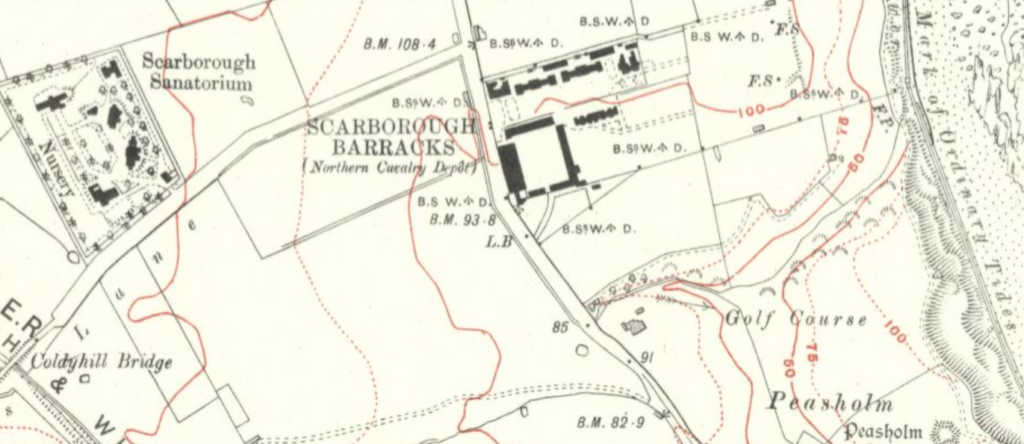The cavalry regiments differed from the infantry regiments in that they were not generally considered to be associated with a specific geographical area. The situation regarding the cavalry depots and record offices that existed during the Great War mainly traced to a reorganisation that began in 1905.
Cavalry Depots
The depot was a physical location at which it would clothe and arm recruits, and store the uniform and equipment of reservists. The basic and cavalry training of recruits was usually carried out there, and in most cases the depots were located at large barracks.
The 1905 reorganisation centred the cavalry into two depots, located at Canterbury in Kent (for the regiments of Dragoons and Lancers) and York (for the Hussars regiments). They were to take the place of the Reserve Squadrons that each Cavalry Regiment had previously maintained. The depot would be responsible for training men who would go on to one of several different cavalry regiments, and would train them in a single composite recruit regiment. The men would be clothed and given insignia of the regiment to which they would be sent after training.
Chapeltown Barracks in Leeds was considered as cavalry depot in 1908 but this did not develop.
In 1909 it was further decided that the duty of recruit training and the keeping of stores would be dispersed to six Cavalry Depots, one for each Command area. This needs some explanation:
Commands
In January 1905, the War Office reorganised its forces into seven geographic Commands and one District (the Army Corps name was dropped): Aldershot Command (HQ at Aldershot), Southern Command (Tidworth with administration at Salisbury), Eastern Command (London), Irish Command (Dublin), Scottish Command (Edinburgh), Northern Command (York), Welsh and Midland Command (Chester) and the London District (London). This was modified slightly in 1907, becoming Aldershot Command (HQ at Aldershot), Southern Command (Tidworth), Eastern Command (London), Irish Command (Dublin), Scottish Command (Edinburgh), Northern Command (York), Western Command (Chester) and the London District (London). This structure remained in place throughout the Great War.
In the reorganisation of the Cavalry Depots, Aldershot and London District would not have one.
The 1909 Cavalry Depots
The new arrangements were as follows, once the facilities had been expanded and modified for the purpose:
- Southern Cavalry Depot would be located at Horfield Barracks in Bristol and train men for the 3rd, 7th, 15th and 19th Hussars
- Eastern Cavalry Depot would be located at Shrapnel Barracks at Woolwich in London and train men for the 5th, 9th, 12th, 16th, 17th and 21st Lancers
- Irish Cavalry Depot would be located at Richmond Barracks in Dublin and train men for the 4th, 8th, 11th and 13th Hussars
- Scottish Cavalry Depot would be located at Piershill in Edinburgh and train men for the 1st and 5th Dragoon Guards and the 1st and 2nd Dragoons
- Northern Cavalry Depot would be located at Burniston Barracks in Scarborough and train men for the 10th, 14th, 18th and 20th Hussars
- Western Cavalry Depot would be located at Seaforth In Liverpool and train men for the 2nd, 3rd, 4th, 6th and 7th Dragoon Guards and 6th Dragoons.

In August 1910 the War Office decided that the Scottish Cavalry Depot should instead be situated in Castle Park Barracks in Dunbar and that the existing depot should move there from Piershill in Edinburgh, leaving the latter place for the artillery. It was stated that the facilities at Dunbar would need to be expanded for the purpose. Work began in June 1911 and the first troops arrived in August 1913.
The Western Cavalry Depot relocated from Seaforth to Newport (Monmouthshire) in October 1913.
At some point, the exact date of which I have yet to determine, the depots were also given numbers (see table below).
Cavalry Record Offices
Until 1905, there was a single Cavalry Record Office located at 41 Pall Mall in London, but in that year Record Offices were established at Canterbury in Kent (for the regiments of Dragoons and Lancers) and York (for the Hussars regiments). The Record Office was responsible for maintaining personnel and unit records of many types, and was the organisation that would communicate with next of kin on behalf of the War Office when a man was wounded, severely ill, or died or declared as missing. This situation remained as such during the Great war.

The Great War locations of the Cavalry Depots
| Depot number and name | Location |
|---|---|
| 1 (Eastern) Cavalry Depot | Woolwich (Shrapnel Barracks) |
| 2 (Irish) Cavalry Depot | Dublin (Richmond Barracks) |
| 3 (Northern) Cavalry Depot | Scarborough (Burniston Barracks) |
| 4 (Western) Cavalry Depot | Newport |
| 5 (Southern) Cavalry Depot | Bristol (Horfield Barracks) |
| 6 (Scottish) Cavalry Depot | Dunbar (Castle Park Barracks) |
Army Order 26 of 1916 specified that cavalry regiments would send any man who was due for discharge on termination of his regular engagement to the depots as follows:
- 1st Cavalry Depot: all regiments of Lancers
- 2nd Cavalry Depot: 4th, 8th, 11th and 13th Hussars
- 3rd Cavalry Depot: 10th, 14th, 18th and 20th Hussars
- 4th Cavalry Depot: 2nd, 3rd, 4th, 6th and 7th Dragoon Guards and 6th Dragoons
- 5th Cavalry Depot: 3rd, 7th, 15th and 19th Hussars
- 6th Cavalry Depot: 1st and 5th Dragoon Guards and 1st and 2nd Dragoons
Regiments of Household Cavalry and the Special Reserve regiments of cavalry would send such men to their own reserve units.
Reorganisation November 1921
The Army Council announced that Numbers 3 and 5 Depots would amalgamate, occupy the Bristol location and that the merged organisation would be called Number 5 Depot. The 10th, 11th, 13th, 14th, 15th and 18th Hussars would be affiliated to this depot.
Number 1 Depot would relocate from Woolwich to Scarborough. The permanent establishment of a depot staff would be cut to two officers and 16 other ranks.